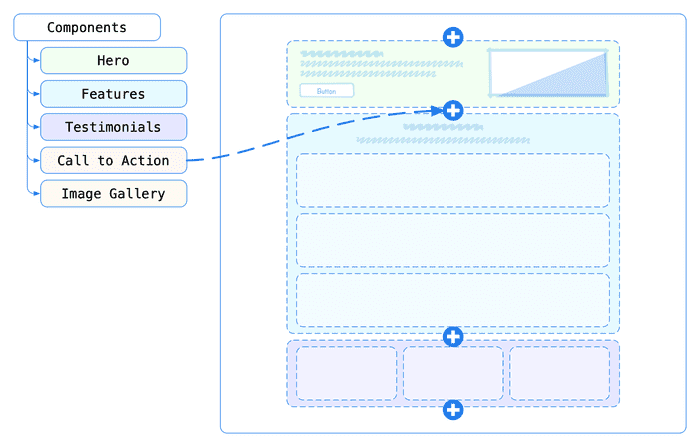For almost three decades, WYSIWYG ("what you see is what you get") site builders have empowered the masses to build their own web presence without manually editing code. Site builders’ importance to the modern web can’t be understated, and they can power Jamstack sites.
How a Site Builder Works
The earliest tools, like Geocities and Microsoft Frontpage, simply injected a point-and-click interface for creating basic HTML tags (paragraph, image, boldface...) into the web page rendered by the resulting code.
As standards for the web matured around design systems, the drag-and-drop nature of WYSIWYG editors remained familiar, but popular site builders like Squarespace, Wix, Weebly, and Webflow evolved the default "editable unit" from a simple HTML tag into an entire component with complex code under the hood.

Why Site Builders Rock
Modern site builder components — and the themes they're available within — pre-packaged fonts, colors, whitespace, and images into cohesive, attractive page sections.
Components are the hidden magic behind site builders today. Their well-thought-out design constraints actually inspire creativity, because site authors can experiment without worrying that they'll "break" the site or make it "ugly."
The Problem with Site Builders
But there's trouble in paradise. Unless you're building a super simple site, eventually you're going to need to write some code. Solutions to crucial business problems might require extending a site's functionality through:
- Visuals: Adding an animation to a component that isn't supported through the site builder's editor.
- Content: Adding a new field to a component (e.g. a subtitle to a product preview card).
- Integrations: Pulling in a list of products from your database.
Low-code site builders allow some customization, but they simply can't think of everything. Nor should they — simplicity is a superpower for many of their users.
To make up for their simplicity, most no-code site builders have a plugin ecosystem, but even these bump into limitations:
- Developers may be forced to write code in the site builder's language of choice.
- Community plugins can become unmaintained or have security vulnerabilities.
- Plugins might not quite give you exactly what you need.
Stackbit: A Site Builder for Developers
Stackbit is the Jamstack site builder for developers. It puts the developer first and expects you to change your site's code. Full-code for devs, no-code for editors.
Stackbit sets you up with modern tooling and best practices. Leveraging the Jamstack to pre-render content and serve it from the edge improves your site's performance, modularity, security, and cost. Start with one of our themes and innovate in your favorite Git workflow (including our embedded VSCode editor).
Show off your Site Builder
Share what you’ve built with Stackbit on Twitter with #MadeWithStackbit. We can't wait to see the site builders you come up with!













